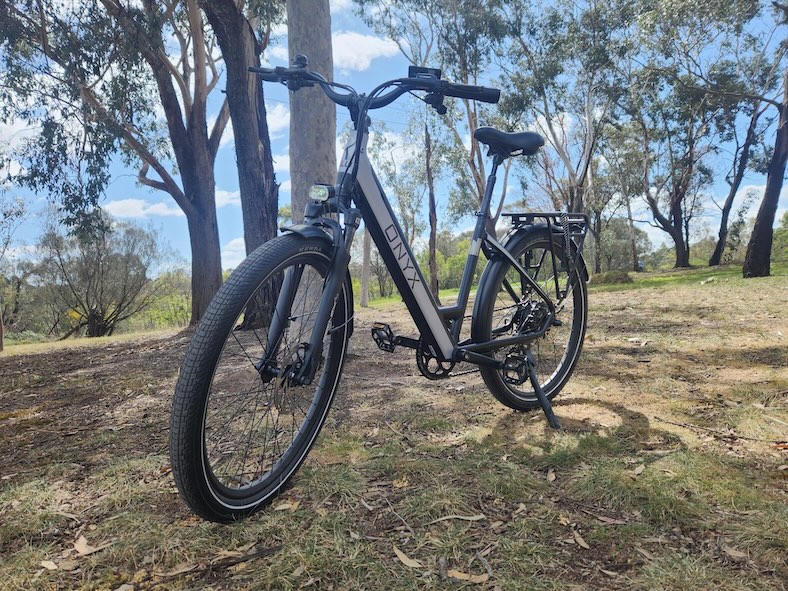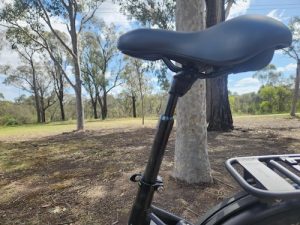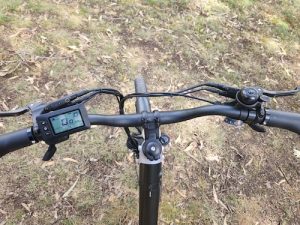Table of Contents
The good stuff
- Great comfort
- Several bottle mount points
- Simplicity and cleaningless in the design
Potential improvements
- Walk-Assist speed provided could be lower
-
Motor assistance & PAS
-
Battery range
-
Weight
-
Responsiveness & Comfort
-
Accessories
-
Technology combo
-
Warranty
The Rilu Onyx is a step-thru electric bike designed in Australia, focusing on comfort and practicality for city commuting and occasional light off-road paths.
Rilu E-Bikes provided this model for testing purposes. All opinions are entirely my own, and I have not received any payment for this review.
Onyx Specs Summary (basic)
| E-BIKE MODEL: 4th Generation
PURPOSE: City and Low-Level Gravel Rides MOTOR & TOP SPEED
|
BATTERY
|
RANGE (based on brand information and EBA tested)
|
CONTROLLER, RIDING MODES, & DISPLAY
|
FRAME
|
GEAR SYSTEM
|
BRAKING SYSTEM
|
RILU ONYX WEIGHT
|
| TYRES & SUSPENSION Tyres:
Suspension:
|
SENSORS
|
FEATURES
|
PRICE & WARRANTY
|
Rilu Onyx Review: My Findings
Terrains tested
I tested the Onyx across three (3) different terrains:
- A compacted gravel path to test grip, handling, and how the bike responded on loose surfaces.
- Asphalt with both uphill and downhill sections (approximately a 15% incline) to assess the responsiveness of the motor, braking system, and balance on descents.
- Grass and uneven surfaces to observe comfort, suspension performance, and overall frame sturdiness.
First impressions
- My first visual impression of the Onyx was somewhat positive. Contrary to what I experienced with the Rilu Nomad, this one looked more like a standard bike than an e-bike.
- The frame finishing appeared smooth and well-polished, as if a lot of thought was put into making it look humble.
I have reviewed other compact and step-thru e-bikes in the past, and the Onyx gave me a sense of stronger build quality compared to several others in the same class.
Test Ride: Speed Levels (SL)
Contrary to what I’ve seen on the pedal-assist (PAS) approach, Rilu used a Speed Level (SL) system to provide the rider with motor support.
Each level stopped the assistance when I reached a somewhat specific speed limit. During my ride, I noticed the cut-off occurred later than I expected, but it was consistent. I think this is a minor, but noticeable detail.
No assistance experience
- The Rilu Onyx weighs around 27 kg, landing in the mid-range weight category for e-bikes; however, the ride felt smooth and easy.
- When climbing, I was pleasantly surprised at how easily it rode without assistance.
This was important to me, as some heavier e-bikes I’ve tested felt too sluggish without motor support.
Speed Levels impressions and differences: SL1, SL5, and SL9
- Starting with SL1, the assistance felt gentle and steady, cutting out around 7 km/h. On hills, though, I had to put in some effort, which was fair given the lower speed cap. In this instance, I think it was perfect for cruising along the flat paths.
- Moving up to SL5, it felt like the Onyx came alive, picking up speed quickly, reaching about 19 km/h in just a few more seconds. Even on inclines, I barely had to pedal harder to keep the pace, and it held steady without struggling.
- At the top setting, SL9, the motor pushed a bit more than 25 km/h (maximum legal speed in Australia) comfortably. It handled steeper climbs confidently and maintained the speed with ease.
I didn’t notice a massive difference in raw power between SL5 and SL9, but SL9 definitely made it easier to hold a consistent, faster pace.
Test Ride: Comfort and Ride Feel
- The Onyx included a front suspension and a seatpost with minimal shock absorption capabilities, a rare find for a step-thru commuter e-bike. Both contributed greatly to my overall ride experience.
- I appreciated the stable handling, especially when turning at higher speeds.
After about one (1) hour of riding on mixed terrains, I still felt relaxed with no wrist or back fatigue.
The Rilu Onyx Controller
While the controller isn’t as advanced as systems like Bosch and the newest Bafang versions, my impression was that it’s well integrated:
- All functions are consolidated into a single, easy-to-read display.
- The interface clearly provided all the essential data.
The operation was simple and intuitive, and easy to read, especially on a bright day. At night, I think the display was brighter, but I didn’t feel it was interfering with my vision.
Controller error messages
A thoughtful feature was the real-time display of error codes if there’s a malfunction in the motor, battery, or controller. This avoids needing an app to diagnose issues, something many large-brand systems require.
Tip: Consult the Rilu manual for a list of these codes—it’s a helpful inclusion.
Rilu Onyx walk-assist mode test
This mode proved practical when I needed to push the bike across gravel or obstacles.
Although I had a good experience with this feature when reviewing the Nomad, on this occasion, it felt like the walk-assist mode was over-giving assistance, reaching a speed of 5.5 km/h. For me, and maybe other riders, this was too fast.
The Throttle Feature
Throttle functions remain a popular topic of discussion in Australia due to strict e-bike laws.
Find out more about e-bike laws.
- The Onyx’s throttle had the option to reach either 6 km/h or 20 km/h, depending on the chosen setting. The power delivery felt consistent across both options.
- I liked the thumb-activated throttle over the twist-grip type—it was easier on my wrist and gave smoother control.
Things I Loved About the Onyx
1. Comfort while riding: the front suspension, saddle comfort, and extra added sock absorption of the seat post made my ride pleasant.
2. Accessory options: I was content with the number of bottle mount points, including on the side of the rear rack (I hadn’t seen it before).
3. Build quality: I really liked how simple the frame looked, and the joints were robust and had a clean finish.
The Potential Deal-Breaker?
The Onyx impressed me more than I expected, but one slight improvement could make it even better: the walk-assist speed could be fine-tuned to consistently stay around 4 km/h for better control while walking.
Who Is The Rilu Onyx For? Conclusions
Few step-thru e-bikes have left a lasting impression on me, but this one did, too. I rode confidently, felt in control, and performed well across varied terrain.
In my view, the Rilu Onyx is a good option for riders looking for a comfortable e-bike for long-distance rides.
Have you ridden the Onyx yet? I’d love to hear your thoughts in the comments below.






